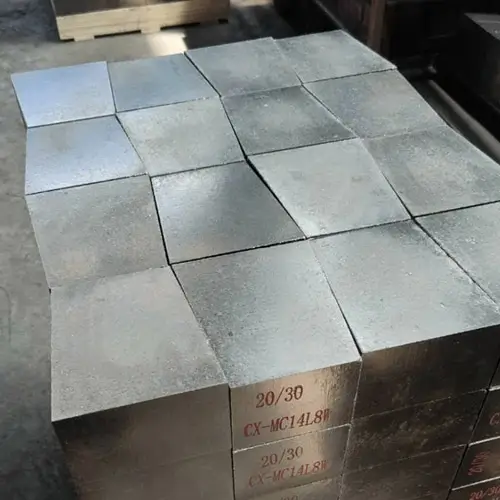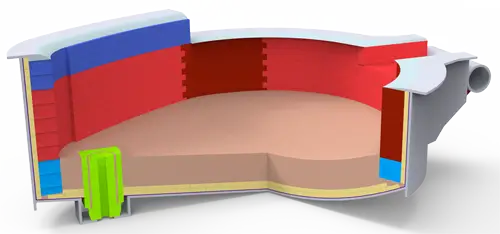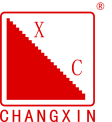The bottom of the electric furnace and the embankment slope together constitute the molten pool, and its refractory material is directly subjected to high-temperature heat load and slag erosion. Steel flushing, mechanical impact of scrap and oxidation and reduction operations in the furnace at high temperatures make the slag penetrate to the bottom of the furnace, resulting in the thinning of the bottom of the furnace.
Refractories for the bottom of ultra-high-power electric furnaces
Refractories for the bottom of UHF furnace are divided into refractories for adiabatic layer, refractories for permanent layer and refractories for working layer.
1.Refractories for insulating layers
Insulation layer is the lowest layer of the furnace bottom, its role is to reduce the heat loss of the electric furnace, and to ensure that reduce the temperature difference between the molten pool of liquid steel above and below. Usually, the furnace shell is first laid a layer of asbestos sheet, and then laying diatomaceous earth powder, above which a layer of adiabatic bricks are laid flat.
2.Refractories for permanent layers
The role of the permanent layer is to ensure the solidity of the molten pool and prevent steel leakage. Usually the permanent layer with MgO for 95% ~ 96% of the fired magnesium brick masonry, magnesium bricks are first trimmed with a brick grinder to ensure the quality of bricklaying. Magnesium brick refractoriness up to 2000 ℃ or more, its load softening start temperature, general magnesium brick in 1520 ~ 1600 ℃, and high purity magnesium brick up to 1800 ℃. 20 ~ 1000 ℃ under the magnesium brick linear expansion rate is generally 1.2% ~ 1.4%, and approximate linear. The thermal conductivity of magnesium bricks is high, second only to carbon bricks and silicon carbide bricks in refractory products, and decreases with the increase of temperature. The thermal shock resistance of magnesium bricks is poor, improve the purity of magnesium bricks can be appropriate to improve the resistance to thermal shock. Magnesium bricks at room temperature conductivity is very low, but at high temperatures such as 1500 ℃ but can not be ignored, if used in the bottom of the electric furnace should be noted. Ordinary magnesium brick firing temperature is generally 1500 ~ 1650 ℃, high purity magnesium brick firing temperature is as high as 1700 ~ 1900 ℃. The part can also use magnesium carbon brick masonry, but it is relatively rare.

3.Refractories for working layers
The refractory material used in the working layer is in direct contact with molten steel and slag, and is directly exposed to high temperature heat load and slag erosion. The scouring of molten steel, the mechanical impact of the scrap steel, and the oxidation and reduction operation in the furnace at high temperature make the slag penetrate into the bottom of the furnace, resulting in the thinning of the bottom of the furnace. And in non-continuous operation, the dicalcium silicate in the slag absorbs the moisture in the atmosphere and collapses and falls off, reducing the durability of the material and affecting its service life. Therefore, the layer of refractory material should have: good sintering performance, in the guaranteed sintering temperature under the rapid sintering and the formation of a certain strength and a certain thickness of the sintered layer, enough to resist the mechanical impact of the charge. Suitable expansion properties, its expansion and contraction will not produce localized excessive cracks to reduce the intrusion of molten steel and slag, nor will the cracks produced by contraction lead to localized floating, to ensure that the furnace can be operated continuously. Large natural packing density and post-sintering density can avoid uneven density caused by construction and sintering, and also have high resistance to steel water and steel holdout penetration. High resistance to steel water and steel holdout erosion, low erosion rate, uniform erosion, and long service life. The hot surface of furnace bottom has strong affinity with new furnace bottom tamping material, which can ensure the repair effect.
Normal power electric furnace bottom refractory
There are usually two types of ordinary power electric furnace bottom.
① Knotted furnace bottom (or vibration compression furnace bottom). Magnesia sand is used for the working layer, and the binding agent is tar and asphalt, while brine or water glass is used as the binding agent for the production of carbonless furnace lining.
② Brick furnace bottom. Usually combined with asphalt magnesium bricks, carbonless furnace lining with brine combined with magnesium bricks.
At present, the working layer of high-power and ultra-high-power electric furnaces generally use magnesium dry tamping material construction, the material is high iron and high-calcium synthetic magnesium sand and electrolytic magnesium sand as aggregate, synthetic magnesium sand and electrolytic fusion magnesium sand as fine powder, the critical size of 5 ~ 6mm, synthetic magnesium sand C2F (dicalcium ferrite) as an auxiliary sintering agent, do not add any combining agent, the use of multi-stage batching and become. It is constructed by strong pounding to ensure the density after construction, and it can be sintered into a solid whole at the appropriate temperature, and its service life is several times higher than that of the previous method of pounding and bricklaying. Generally speaking, the one-time service life of dry tamping material can reach more than 300 furnaces, and it can be extended to 500~600 furnaces through hot repair, which not only reduces the number of furnace stops, but also reduces the consumption of refractory materials per ton of steel significantly.

